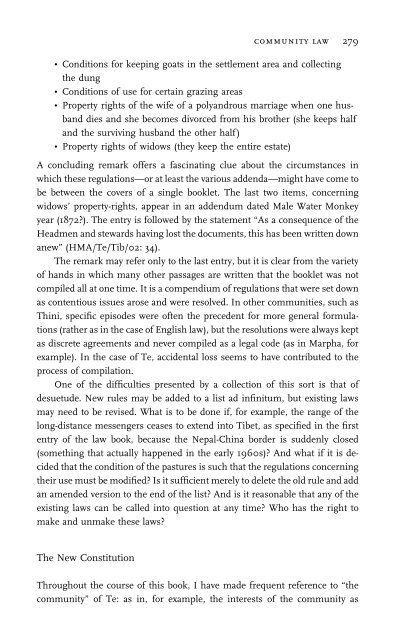Navel of the Demoness : Tibetan Buddhism and Civil Religion in ...
Navel of the Demoness : Tibetan Buddhism and Civil Religion in ...
Navel of the Demoness : Tibetan Buddhism and Civil Religion in ...
You also want an ePaper? Increase the reach of your titles
YUMPU automatically turns print PDFs into web optimized ePapers that Google loves.
134 <strong>the</strong> navel <strong>of</strong> <strong>the</strong> demoness<br />
The traditional <strong>in</strong>alienability <strong>of</strong> <strong>the</strong> estate from <strong>the</strong> clan is illustrated by <strong>the</strong><br />
case <strong>of</strong> <strong>the</strong> Önpo, one <strong>of</strong> <strong>the</strong> six orig<strong>in</strong>al clans <strong>of</strong> Te. The last member <strong>of</strong><br />
<strong>the</strong> Önpo died long ago—probably <strong>in</strong> <strong>the</strong> middle <strong>of</strong> <strong>the</strong> n<strong>in</strong>eteenth century.<br />
The Önpo estate was not <strong>in</strong>herited by any o<strong>the</strong>r clan but became communal<br />
property. This is one <strong>of</strong> <strong>the</strong> two ‘‘empty’’ estates that are still held <strong>in</strong>tact by <strong>the</strong><br />
community. The old association between clan <strong>and</strong> estate is still susta<strong>in</strong>ed <strong>in</strong><br />
<strong>the</strong> cont<strong>in</strong>u<strong>in</strong>g appellation <strong>of</strong> <strong>the</strong> group <strong>of</strong> fields <strong>and</strong> <strong>the</strong> now-derelict house<br />
<strong>in</strong> <strong>the</strong> north-western corner <strong>of</strong> Dzong as <strong>the</strong> ‘‘Önpo estate.’’<br />
A f<strong>in</strong>al observation may be made about document HMA/Te/Tib/06 before<br />
I move on to consider o<strong>the</strong>r manifestations <strong>of</strong> clan <strong>in</strong>tegrity. For some reason,<br />
<strong>the</strong> Cimden clan is be<strong>in</strong>g required to give l<strong>and</strong> to <strong>the</strong> village. Although we are<br />
not told about <strong>the</strong> exact circumstances <strong>of</strong> <strong>the</strong> request, <strong>the</strong> <strong>in</strong>evitable effect is to<br />
<strong>in</strong>crease <strong>the</strong> resource base <strong>of</strong> <strong>the</strong> community as a whole at <strong>the</strong> expense <strong>of</strong> a<br />
particular clan.<br />
The last generation or two has seen <strong>the</strong> ab<strong>and</strong>onment <strong>of</strong> what appears to<br />
have been a ra<strong>the</strong>r strict regulation <strong>of</strong> <strong>in</strong>heritance by clan <strong>in</strong>terests, <strong>and</strong> <strong>the</strong><br />
consequences for <strong>the</strong> community are significant. To what extent was this ideal<br />
<strong>of</strong> clan priority <strong>in</strong> <strong>in</strong>heritance realised <strong>in</strong> practice? The short answer is that we<br />
do not know. There are no written records that could help us, <strong>and</strong> genealogical<br />
memory is too shallow to permit <strong>the</strong> emergence <strong>of</strong> a discernable pattern.<br />
But let us see what <strong>the</strong> situation looks like now. There are forty-six occupied<br />
estates <strong>in</strong> Te. In thirty-seven cases, <strong>the</strong> present heads are <strong>the</strong> sons <strong>of</strong> <strong>the</strong><br />
previous head. This leaves n<strong>in</strong>e estates that had no sons. How have <strong>the</strong>se<br />
solved <strong>the</strong> problem <strong>of</strong> <strong>in</strong>heritance?<br />
(1) Töpa 6: Paten to Khyungpo<br />
The old head was a Paten <strong>and</strong> his wife a Butra. They had one daughter<br />
(Paten), who married out <strong>in</strong>to a Butra estate. The daughter <strong>of</strong> <strong>the</strong> same estate<br />
was brought <strong>in</strong> as <strong>the</strong> daughter-<strong>in</strong>-law <strong>of</strong> Töpa 6, <strong>and</strong> <strong>the</strong> son-<strong>in</strong>-law, her<br />
husb<strong>and</strong>, is a Khyungpo.<br />
(2) Töpa 7: Yangpa to Paten<br />
The old head was a Yangba <strong>and</strong> his wife a Paten. None <strong>of</strong> <strong>the</strong>ir many<br />
children survived, <strong>and</strong> both a son-<strong>in</strong>-law (Paten) <strong>and</strong> daughter-<strong>in</strong>-law were<br />
brought <strong>in</strong> to <strong>in</strong>herit <strong>the</strong> estate.<br />
(3) Töpa 12: Paten to Yangba<br />
The daughter <strong>of</strong> <strong>the</strong> estate had no bro<strong>the</strong>rs. She rema<strong>in</strong>ed at home, <strong>and</strong><br />
her <strong>in</strong>-marry<strong>in</strong>g husb<strong>and</strong> is a Yangba.<br />
(4) Sumdu 9: Yangba to Yangba<br />
The old head was a Yangba. He had one daughter, who married <strong>in</strong>to estate<br />
Sumdu 7 (Khyungpo). The daughter <strong>of</strong> Sumdu 7 came to Sumdu 9 as a


